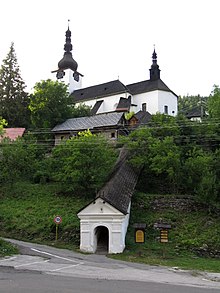world.wikisort.org - Slovakia
Špania Dolina (Hungarian: Úrvölgy) is a village and municipality in central Slovakia, near the city of Banská Bystrica.[4] Although its permanent population does not exceed 200 people, it is a picturesque historic village situated 728 m above sea level and is surrounded by the Staré Hory and Veľká Fatra mountains. It has become a popular tourist recreation centre.
Špania Dolina | |
|---|---|
Village | |
 Špania Dolina from Panský Diel | |
 Coat of arms | |
 Špania Dolina Location of Špania Dolina in the Banská Bystrica Region  Špania Dolina Špania Dolina (Slovakia) | |
| Coordinates: 48°49′N 19°08′E | |
| Country | Slovakia |
| Region | Banská Bystrica |
| District | Banská Bystrica |
| First mentioned | 1254 |
| Government | |
| • Mayor | Martina Wilhelmerová |
| Area | |
| • Total | 12.72[1] km2 (4.91[1] sq mi) |
| Elevation | 711[2] m (2,333[2] ft) |
| Population (2021) | |
| • Total | 222[3] |
| Postal code | 974 15[2] |
| Area code | +421 48[2] |
| Car plate | BB |
| Website | www.spaniadolina.sk |
Name
The ancient Latin name of the village is Valis Dominorum (meaning "Lord’s Valley"). The first part of the Slovak name ("Špania") is derived from another Latin word for "lord": spanatus. The second part ("Dolina") means "valley" in Slovak. The old German name of the village was Herrengrundt and it has been used for centuries by Carpathian Germans living in the area. The Hungarian name of the village is Úrvölgy.
History



Prehistoric mining tools excavated in the territory of Špania Dolina have been dated from as early as 2000-1700 BC. Copper from Špania Dolina has also been identified in bronze artifacts from the Balkans and the Middle East. It indicates that the local mines were part of an extensive network of trade routes during the Bronze Age. However, the first written reference to the village itself only appeared in 1254. Abundant deposits of copper and silver were exploited first by miners from Banská Bystrica and after 1494 by one of the first multinational corporations, founded by the affluent Fugger and Thurzo families.
The rich region attracted many foreign visitors. The House of Fugger funded a laboratory of the famous alchemist Paracelsus there. In 1696, Edward Browne gave description of the mine of Herrengrund (Browne used the German name of the settlement), belonged that time to the Hungarian Kingdom, in his book: Brief account of some travels in Hungaria, Servia, Bulgaria, Macedonia, Thessaly, Austria, Styria, Carinthia, and Friuli. He mentions the very rich ore, „in an hundred ponds of Ore they ordinarily find twenty ponds of Copper”.[5] Browne sent some ore to the prominent English naturalist, John Woodward, these are now in his collection in Sedgwick Museum of Earth Sciences, Cambridge.[6] The prominent French thinker Montesquieu visited and described the copper mines in Špania Dolina upon the encouragement of Isaac Newton.
The ancient tradition of making bobbin lace led to the establishment of a bobbin lace craft school in 1883. The copper mines were closed down in 1888 and the economy of the village is now based primarily on tourism.
Landmarks
A covered stairway leads to a fortified church, built in the Gothic and Renaissance styles. Wooden miners' houses, now reconstructed, were originally built in the 17th and 18th centuries. The so-called "Knocker" from the 16th century served as a special bell tower for calling the miners to work in the morning. Ancient shafts and other technical monuments are scattered in the nearby forests. Špania Dolina is also a hub of hiking, mountain biking, and cross-country skiing trails.
Demographics
Špania Dolina has only 192 residents (as of December 31, 2013). According to the 2001 census, 95.3% of inhabitants were Slovaks and 3% Czechs.[7] The religious makeup was 82.8% Roman Catholics and 10.7% people with no religious affiliation.[7]
References
- "Hustota obyvateľstva - obce [om7014rr_ukaz: Rozloha (Štvorcový meter)]". www.statistics.sk (in Slovak). Statistical Office of the Slovak Republic. 2022-03-31. Retrieved 2022-03-31.
- "Základná charakteristika". www.statistics.sk (in Slovak). Statistical Office of the Slovak Republic. 2015-04-17. Retrieved 2022-03-31.
- "Počet obyvateľov podľa pohlavia - obce (ročne)". www.statistics.sk (in Slovak). Statistical Office of the Slovak Republic. 2022-03-31. Retrieved 2022-03-31.
- "Špania Dolina - Okres Banská Bystrica - E-OBCE.sk". www.e-obce.sk. Retrieved Sep 29, 2020.
- Browne, Edward (1696). Brief account of some travels in Hungaria, Servia, Bulgaria, Macedonia, Thessaly, Austria, Styria, Carinthia, and Friuli. pp. 106–107. Retrieved 2020-08-11.
- Kázmér, Miklós; Papp, Gábor (January 2017). "KÁRPÁTI ÁSVÁNYOK EGY TIZENNYOLCADIK SZÁZADI ANGLIAI GYŰJTEMÉNYBEN" (PDF). Magyar Tudomány (in Hungarian): 68–69. Retrieved 2020-08-12.
- "Municipal Statistics". Statistical Office of the Slovak republic. Archived from the original on 2007-11-16. Retrieved 2007-12-05.
External links
 Media related to Špania Dolina at Wikimedia Commons
Media related to Špania Dolina at Wikimedia Commons- Official website
На других языках
[de] Špania Dolina
Špania Dolina (bis 1927 slowakisch auch „Baňa“; deutsch Herrengrund, ungarisch Úrvölgy – bis 1882 Urvölgy) ist eine Gemeinde in der Mittelslowakei.- [en] Špania Dolina
Другой контент может иметь иную лицензию. Перед использованием материалов сайта WikiSort.org внимательно изучите правила лицензирования конкретных элементов наполнения сайта.
WikiSort.org - проект по пересортировке и дополнению контента Википедии